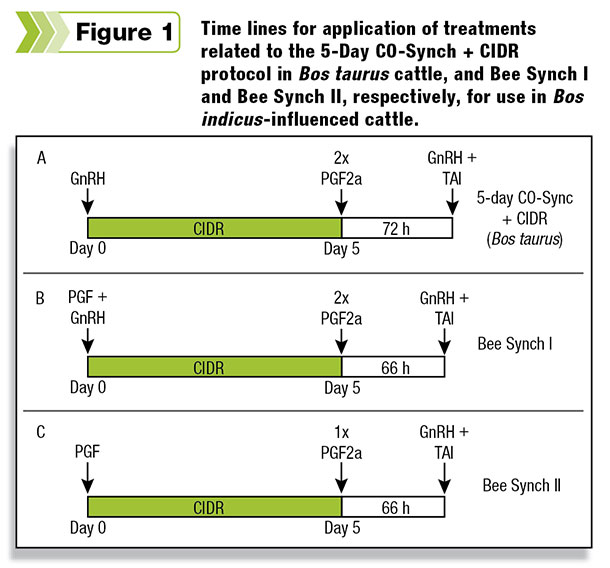Using hormone-based protocols to synchronize estrus and ovulation in combination with fixed-time A.I. (no heat detection) has become increasingly popular in the commercial beef industry.
However, protocols developed for use in straight-bred English and Continental breeds have generally not performed well in Brahman-influenced cattle, with pregnancy rates to fixed-time A.I. often ranging from 35 to 40 percent. As a result, few commercial cattlemen in the southern U.S. have routinely used these technologies.
One of the most successful Bos taurus-based protocols, the so-called “Five-Day CO-Synch + CIDR,” employs application of a CIDR device plus an injection of gonadotropin-releasing hormone (GnRH) on day zero. The CIDR is then removed on day five, and a double dose (all at once or split into two injections eight hours apart) of prostaglandin (PG) is injected.
Fixed-time A.I. is at 72 hours in conjunction with a second injection of GnRH (Figure 1A). Pregnancy rates to fixed-time A.I. in Bos taurus and Bos taurus crosses have been reported to range from 55 to 60 percent in mature cows and 50 to 55 percent in heifers.

Unfortunately, this protocol does not result in acceptable fixed-time A.I. pregnancy rates in Brahman-influenced cattle. However, modifications of the procedure, developed at the Texas A&M AgriLife Research Station in Beeville and called Bee Synch, yielded excellent results in these cattle types.
Based on the theory that Brahman-influenced cattle are more sensitive to the ovarian hormone progesterone than straight Bos taurus females, we added a PG injection at the onset of the standard five-day procedure. This gets rid of functionally mature structures on the ovary (corpora lutea; CL) that secrete progesterone. As a result, the only source of progesterone is the CIDR device.
Experiments involving more than 700 mature females at four locations using Bee Synch (now called Bee Synch I) have resulted in fixed-time A.I. pregnancy rates of 51 to 53 percent, with fixed-time A.I. at 66 to 72 hours after CIDR removal (Figure 1B).
This procedure is now listed in the Beef Sire Directories as “PG Five-Day CO-Synch + CIDR” and is the only protocol using FDA-approved drugs recommended for Bos indicus-influenced females.
Following the widespread announcement of Bee Synch and interest by cattlemen in its application, two issues arose that caused confusion. These included the practice of some promoters ignoring the original name given to the procedure (Bee Synch), referring to it instead as PG Five-Day CO-Synch + CIDR. Most cattlemen do not associate that term with Bee Synch.
In addition, the protocol listed nationally recommends the double dose of PG on day five be split into two doses, eight hours apart. There is no research supporting this recommendation, and its implementation increases labor and stress on the cattle, both of which are unnecessary and potentially detrimental. The recommendation arose through concern that the FDA would not support off-label use of a licensed drug.
Accordingly, a second protocol, Bee Synch II (Figure 1C), has now been developed to remedy this problem. It is based on the belief that the treatment of mature Brahman-influenced cows with GnRH on day zero does not appreciably facilitate the synchronization process. By eliminating this treatment, we also get rid of the requirement for the double dose of PG on day five, as no immature CLs will have been induced on day zero.
Although data are limited at this juncture, fixed-time A.I. pregnancy rates to date for Bee Synch I and II (52 percent) have been equal. As more trials are completed, we are hopeful that Bee Synch II will become the preferred protocol.
If so, it will eliminate the controversy over the double dose of PG on day five and save cattlemen approximately $5 per head in drug costs without any reduction in pregnancy rate.
Pfizer Animal Health (now Zoetis Animal Health) provided all products, including CIDRs, PG (Lutalyse), and GnRH (Factrel), as well as financial support for this work.






